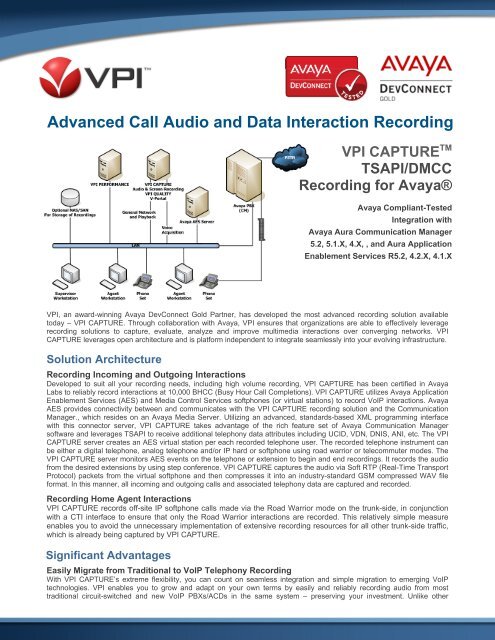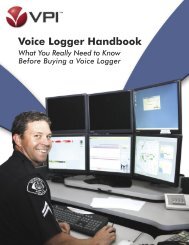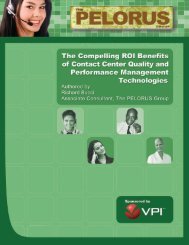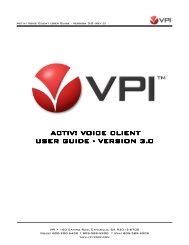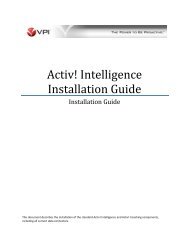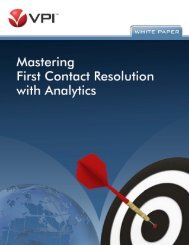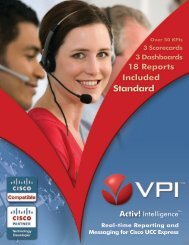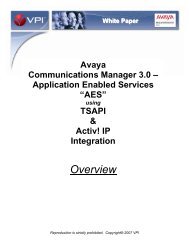Advanced Call Audio and Data Interaction Recording - VPI
Advanced Call Audio and Data Interaction Recording - VPI
Advanced Call Audio and Data Interaction Recording - VPI
You also want an ePaper? Increase the reach of your titles
YUMPU automatically turns print PDFs into web optimized ePapers that Google loves.
<strong>Advanced</strong> <strong>Call</strong> <strong>Audio</strong> <strong>and</strong> <strong>Data</strong> <strong>Interaction</strong> <strong>Recording</strong><br />
<strong>VPI</strong> CAPTURE TM<br />
TSAPI/DMCC<br />
<strong>Recording</strong> for Avaya®<br />
Avaya Compliant-Tested<br />
Integration with<br />
Avaya Aura Communication Manager<br />
5.2, 5.1.X, 4.X, , <strong>and</strong> Aura Application<br />
Enablement Services R5.2, 4.2.X, 4.1.X<br />
<strong>VPI</strong>, an award-winning Avaya DevConnect Gold Partner, has developed the most advanced recording solution available<br />
today – <strong>VPI</strong> CAPTURE. Through collaboration with Avaya, <strong>VPI</strong> ensures that organizations are able to effectively leverage<br />
recording solutions to capture, evaluate, analyze <strong>and</strong> improve multimedia interactions over converging networks. <strong>VPI</strong><br />
CAPTURE leverages open architecture <strong>and</strong> is platform independent to integrate seamlessly into your evolving infrastructure.<br />
Solution Architecture<br />
<strong>Recording</strong> Incoming <strong>and</strong> Outgoing <strong>Interaction</strong>s<br />
Developed to suit all your recording needs, including high volume recording, <strong>VPI</strong> CAPTURE has been certified in Avaya<br />
Labs to reliably record interactions at 10,000 BHCC (Busy Hour <strong>Call</strong> Completions). <strong>VPI</strong> CAPTURE utilizes Avaya Application<br />
Enablement Services (AES) <strong>and</strong> Media Control Services softphones (or virtual stations) to record VoIP interactions. Avaya<br />
AES provides connectivity between <strong>and</strong> communicates with the <strong>VPI</strong> CAPTURE recording solution <strong>and</strong> the Communication<br />
Manager., which resides on an Avaya Media Server. Utilizing an advanced, st<strong>and</strong>ards-based XML programming interface<br />
with this connector server, <strong>VPI</strong> CAPTURE takes advantage of the rich feature set of Avaya Communication Manager<br />
software <strong>and</strong> leverages TSAPI to receive additional telephony data attributes including UCID, VDN, DNIS, ANI, etc. The <strong>VPI</strong><br />
CAPTURE server creates an AES virtual station per each recorded telephone user. The recorded telephone instrument can<br />
be either a digital telephone, analog telephone <strong>and</strong>/or IP hard or softphone using road warrior or telecommuter modes. The<br />
<strong>VPI</strong> CAPTURE server monitors AES events on the telephone or extension to begin <strong>and</strong> end recordings. It records the audio<br />
from the desired extensions by using step conference. <strong>VPI</strong> CAPTURE captures the audio via Soft RTP (Real-Time Transport<br />
Protocol) packets from the virtual softphone <strong>and</strong> then compresses it into an industry-st<strong>and</strong>ard GSM compressed WAV file<br />
format. In this manner, all incoming <strong>and</strong> outgoing calls <strong>and</strong> associated telephony data are captured <strong>and</strong> recorded.<br />
<strong>Recording</strong> Home Agent <strong>Interaction</strong>s<br />
<strong>VPI</strong> CAPTURE records off-site IP softphone calls made via the Road Warrior mode on the trunk-side, in conjunction<br />
with a CTI interface to ensure that only the Road Warrior interactions are recorded. This relatively simple measure<br />
enables you to avoid the unnecessary implementation of extensive recording resources for all other trunk-side traffic,<br />
which is already being captured by <strong>VPI</strong> CAPTURE.<br />
Significant Advantages<br />
Easily Migrate from Traditional to VoIP Telephony <strong>Recording</strong><br />
Specifications With <strong>VPI</strong> CAPTURE’s subject extreme to change. flexibility, you can count on seamless integration <strong>and</strong> simple migration to emerging VoIP<br />
technologies. <strong>VPI</strong> enables you to grow <strong>and</strong> adapt on your own terms by easily <strong>and</strong> reliably recording audio from most<br />
traditional circuit-switched <strong>and</strong> new VoIP PBXs/ACDs in the same system – preserving your investment. Unlike other
offerings that require a complete system change-out to migrate from recording in a traditional telephony environment to<br />
recording in a VoIP environment (i.e. different software, different hardware etc.), with <strong>VPI</strong> CAPTURE, simply change the<br />
voice interface boards in the server.<br />
Minimize Impact on Precious Network Resources<br />
<strong>VPI</strong> CAPTURE leverages Avaya’s Telephony Services Application Programming Interface (TSAPI) interface to record all<br />
VoIP traffic, including SPAN <strong>and</strong> RSPAN, with very little impact on your network resources. This is the first solution to make<br />
true video quality screen recording in a VoIP environment a reality without compromising the quality of video recording or<br />
impacting network performance. Unlike other technologies that constantly stream data over the network, file transfer of<br />
screen recordings originally captured at local PC workstations can be either continuous upon conclusion of every recording<br />
session or via scheduled bursts after hours, when the network is less busy.<br />
Capture All <strong>Audio</strong> in St<strong>and</strong>ard GSM File Format<br />
<strong>VPI</strong> CAPTURE’s unique interface has the ability to perform transcoding on the fly, normalizing <strong>and</strong><br />
compressing all audio (including G.711, G.723.1, G.729A, etc.) into industry st<strong>and</strong>ard, non-proprietary<br />
GSM file format regardless of audio sources. This allows for simple, centralized storage <strong>and</strong> playback<br />
using any st<strong>and</strong>ard media player (does not require CODECS to be installed on the PC prior to playback).<br />
Software Specifications<br />
Configuration<br />
• 16 to 192 channels (ports) per server, <strong>and</strong> can be networked to up to unlimited<br />
channels<br />
Operating System Support<br />
• Server - Windows 2000 <strong>and</strong> 2003<br />
• Client - Windows XP <strong>and</strong> ME<br />
Playback Client Software Specifications<br />
• Windows XP SP3, Microsoft Vista Business <strong>and</strong> Ultimate 32 or 64 bit version<br />
(audio recording only)<br />
• Minimum PC hardware requirements are Intel® Pentium III 1 GHz, 1GB RAM;<br />
2GB RAM recommended, Minimum 5GB available disk space<br />
• Web Browsers Supported: Microsoft Internet Explorer 7 <strong>and</strong> 8<br />
Client Server Protocols<br />
• TCP/IP • IPX-SPX • NetBeui • RAS • Windows Sockets St<strong>and</strong>ard<br />
<strong>Audio</strong> <strong>Recording</strong><br />
• Host-based record/play, WAV format (G.711, G.726, MS-GSM)<br />
• Playback speed control with pitch correction<br />
• Record/play via st<strong>and</strong>ard HTTP Web interface<br />
<strong>Audio</strong> Processing<br />
• G.711, G.723.1, G.729A, G.726/G.727, NetCoder ®<br />
• Voice Activity Detection (VAD) <strong>and</strong> CNG<br />
• Echo Cancellation: G.168 compliant 32, 64 msec echo tail;<br />
• 128 msec tail available with reduced channel capacity<br />
• Trans-coding of G.711 RTP to any Low Bit Rate Coder RTP stream<br />
• Gain Control: Automatic (AGC) or Programmable<br />
Signaling<br />
• Ability to decode multiple VoIP protocols such as H.323, SIP, <strong>and</strong> Avaya’s H.323<br />
Physical Interfaces<br />
• TDM Interfaces - MVIP, SCbus, H.100<br />
• Telephony - 120 Ohm - RJ48C connectors<br />
• Ethernet - RJ-45<br />
Playback Output<br />
• Speakers - Multimedia PC Speakers<br />
• Headphone Jack - 1/8” Headphone jack<br />
• Remote - 600 ohms nominal<br />
Security<br />
• Multiple secure login levels. End-to-End <strong>and</strong> AES 256 File Encryption. Complete<br />
audit trail reporting of activities, i.e., login attempts, call searches, etc.<br />
Alarms, Remote <strong>and</strong> On-site Diagnostics, <strong>and</strong> Reports<br />
• Event Center Leverages St<strong>and</strong>ard Network Monitoring Services to Support<br />
Windows Performance/Event Monitor, HP Openview, Tivol, etc.<br />
• Alarms generated locally or via the LAN, can be dialed out to pagers, E-Mailed,<br />
or provided audibly to fixed or cellular telephones. Audit trails, call usage, login/<br />
logout, call search <strong>and</strong> much more.<br />
Customer Requirements<br />
<strong>VPI</strong> CAPTURE Hardware (<strong>VPI</strong> or customer provided)<br />
• <strong>VPI</strong> CAPTURE voice server<br />
AES 4.2, 5.2 <strong>and</strong> Higher License Requirements<br />
\<br />
Licensing Requirements for AES 4.2 <strong>and</strong> 5.2 with Avaya Communication<br />
Manager 5.1 or Higher:<br />
• Qty (1) AES CMAPI\DMCC License per extension* (If using AE Services<br />
Release 4.2 with CM Release 5.1 or 5.2, the DMCC license can be used in<br />
place of IP_IP_A. The IP_API_A is required if AE Services Release 4.2 does<br />
not have a DMCC license or if it is being used with CM 5.0 or lower)<br />
• Qty (2) AES TSAPI Basic Licenses per recorded extension<br />
• Qty (1) AES TSAPI Basic License per recorded hunt group<br />
Licensing Requirements for AES 4.2 with Avaya Communication Manager<br />
5.0 or Lower:<br />
• Qty (1) AES CMAPI\DMCC License per extension*<br />
• Qty (2) AES TSAPI Basic Licenses per recorded extension<br />
• Qty‐(1) AES TSAPI Basic License per recorded hunt group<br />
Licensing requirements for AES 5.2 with Avaya Communication Manager CM<br />
5.1, CM 5.2 or higher:<br />
• Qty (1) License per recorded extension:<br />
o DMCC Full Software License AES 5.x (Includes Station License) [227606]<br />
• Qty (2) License per recorded extension:<br />
o AES TSAPI Basic License 5.2 [227571]<br />
• One(1) each License per Hunt Group:<br />
o AES TSAPI Basic License 5.2 [227571]<br />
About <strong>VPI</strong><br />
<strong>VPI</strong> (Voice Print International, Inc.), an award-winning Avaya DevConnect partner since 2002, is the premier innovator <strong>and</strong><br />
provider of integrated call recording <strong>and</strong> quality management solutions for contact centers, government agencies <strong>and</strong> first<br />
responders. <strong>VPI</strong>’s award-winning solutions help over 1,300 organizations worldwide improve workforce performance, build<br />
customer loyalty, minimize risk <strong>and</strong> ensure compliance. For more information, visit www.<strong>VPI</strong>-corp.com or call (800) 200-5430.<br />
*Some features <strong>and</strong> applications mentioned may require a future release <strong>and</strong> are not available in the initial<br />
release. Future product releases <strong>and</strong> applications are subject to availability <strong>and</strong> cost. Specifications are subject<br />
to change without notice. Some features may require additional hardware <strong>and</strong>/or specific software. All products<br />
<strong>and</strong> services mentioned are the trademarks, service marks, registered marks or registered service marks of<br />
their respective owners.<br />
Updated 7/10/2010


